As promised, albeit belatedly, the tutorial for a very easy pair of trousers/jogging bottoms/pyjama bottoms. I blogged about the 'jeans' I made for petit garçon
here and I have also used the same process to make pyjama bottoms (without the pockets).
Step One: find a pair of trousers that fit well
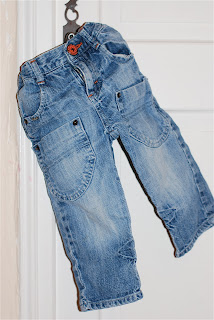 |
| trousers to use as pattern |
Step Two: Lay them backside down on top of the paper you want to use as pattern paper and then fold over so that the front sides are folded together.
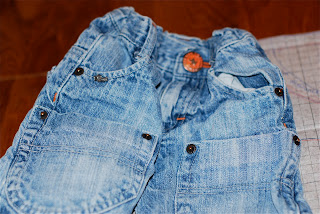 |
| lay trousers on pattern paper and fold |
Step Three: Draw around the trousers - I tend to leave about 2 1/2 cm all the way round for seam allowance and ease - it is easy to take them in if they are too big but not so simple to let out if you have already cut them out.
 |
| draw round trousers to get pattern piece number one |
Make sure at the top that you pull the waistband out, particularly if it is elasticated on the pair of trousers you are using as your pattern base, to get the correct width.
Step Four: Place your pattern piece on your chosen fabric.
If you want to make trousers WITHOUT pockets place the long straight edge on the FOLD of the fabric and cut two of fabric - both on the fold.
If you are making trousers with pockets you should cut 4 of the basic pattern piece - or two doubled over but not on the fold.
Step Five (for pocket version only): If you are making trousers with pockets as per
petit garçon's jeans you need to cut out a square for the back of the pockets
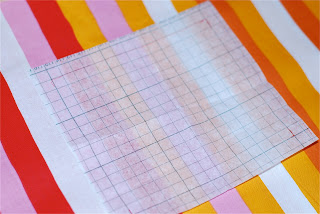 |
| square for back of pocket |
and the front inside part of the pocket as shown below
 |
| front inside of pocket |
To find the size of the square and the front inside of pocket go back to pattern piece one and mark on where you would like the pocket to go
You will see below I have marked the square for the back of the pocket in pins
and here, where the opening for the pocket will go which gives you the shape for the pattern piece for the front inside pocket
The two sections marked with pins above are the two extra pattern pieces you need to add the pockets.
Step Six (only for pocket version): Once you have cut the extra two pieces as set out in step 5 you should take the front inside pocket pattern piece and place it over two pieces cut out of pattern piece one (as cut out in step 4) - the pieces that you want to be the fronts of the trousers. You then need to cut away where the opening for the pocket will go - to match the inside pocket front piece. The other two pieces, which will be the backs of the trousers should be left as they are.
Step Seven: Cut out a waistband approximately 6 centimetres deep (or twice the width of your elastic plus 2 centimetres) and four times the width of the top of pattern piece one (before cutting away for the pocket opening) plus 4 centimetres.
Step Eight: To recap, before we start sewing, you should at this stage have the following (for the pocket version):
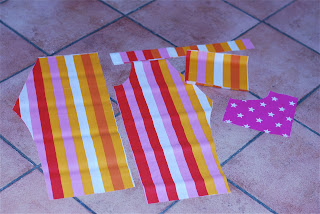 |
| the pieces you should have |
- two back trouser pieces
- two front trouser pieces (with the opening for the pocket cut out)
- one waistband
- two square backs of pockets; and
- two inside fronts of pockets
Step Nine: pin the inside fronts of pocket, right sides together to the front sections of pattern piece one (as shown below)
and sew them together.
Trim the seam allowance and clip into the curve so that when you turn the inside pocket section to the other side it will lie flat.
 |
| clip into the curve |
Turn the inside pocket section to the inside and press.
Step Ten: Pin the square piece (the pocket back) to the inside front pocket section as shown, right sides together - taking care not to catch the front section of the trousers.
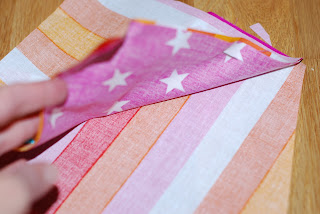 |
| take care not to catch the front trouser section |
Sew around the sides that you have pinned (in the photo below that is the bottom two sides).
 |
| the back view of the pocket once sewn in |
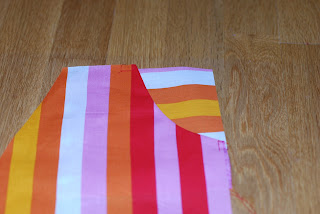 |
| the front view |
Step Eleven: Place the back section of the trousers and the front section together, right sides together, and sew the long straight seam.
Finish the seam, with an overlocker or pinking shears
And you will then have two sections like this:
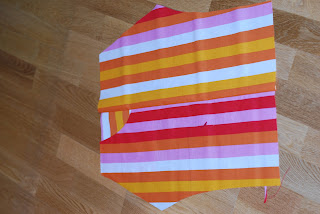 |
| front view |
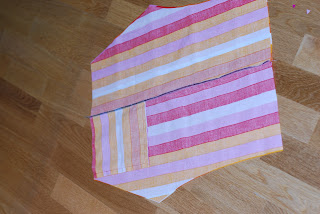 |
| back view |
Step Twelve: Place the two sections, right sides together as shown below
and pin the top two side sections - as shown by the three pins in the photo below.
Sew both side top sections.
and finish the seams
Step Thirteen: Pull on the centre seam in front of you and place the trousers so that they resemble trousers!
Step Fourteen: Pin up and down the inner leg seam and sew in one continuous seam.
Clip the seam in the crotch so that the trousers do not bunch when you turn them the right way round.
Step Fifteen: Attach the waistband to the top of the trousers right sides together
and sew to trouser top.
Step Sixteen: If using elastic, skip this step. I decided to make these trousers draw string waisted so on the inside of the waistband, just above the trouser top in the centre of the front I added a strip of fusible interfacing
and then made two small button holes, for the drawstring to come through.
I attached the drawstring to the centre back of the waistband.
Step Seventeen: Press a small hem allowance all the way round the top of the waistband and then fold over the drawstring and press again. If you are using elastic you should skip step 16 and just press the hem allowance down and then fold over the waistband and press.
Step Eighteen: Pass the ends of the drawstring through the button holes and keeping the drawstring in the fold sew the waistband down, taking care not to catch the drawstring in your sewing (I pinned the drawstring high up in the fold to ensure it wouldn't get caught.
If you are using elastic sew the waistband down leaving a 5 cm gap through which you can pass your elastic. Attach one end of the elastic to a large safety pin and thread the elastic through the waistband. Pull the elastic through to the correct size, zigzag the ends together and then sew up the gap in the waistband.
Step Nineteen: Hem your trousers (I pressed up a small hem and then folded it over again and stitched round).
Step Twenty: Sew in your label (if you have one), pat yourself on the back, make yourself a cup of tea and
admire your work!
I hope this is clear - if you have any questions please leave in the comments below.
Happy sewing!









